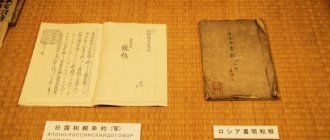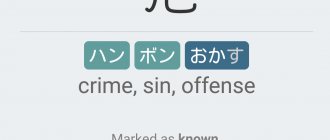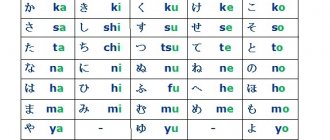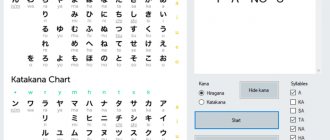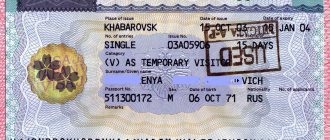The Japanese language (Japanese Nihongo) is a language spoken by about 125 million (9th in the world) inhabitants of Japan, as well as descendants of the Japanese who moved to other countries in the first half of the 20th century: to the USA, including the Hawaiian Islands, Brazil , Peru, China, Canada, Argentina, Mexico, Taiwan, Australia, South Korea. The number of fluent speakers reaches about 140 million people. It is classified as a separate language group, but most researchers recognize it as related closer to the Altai family of languages: Korean, Mongolian, Turkic. It has an original writing system that combines ideography and syllabic phonography. In terms of grammatical structure, it is agglutinative with a predominantly synthetic expression of grammatical meanings.
There are two common names for the Japanese language . In the context of other languages of the world, teaching Japanese to foreigners abroad, the name nihongo (日本語) , that is, literally “Japanese language”. However, as part of the national culture, as a subject of study in Japan, as the mother tongue and official language, it is usually called kokugo (國語 or 国語) , literally "language of the country" or "national language" (the term can be applied not only to the Japanese language, but by default means exactly that).
It is difficult to indicate the exact date of the birth of the Japanese nation, since before the introduction of Chinese characters, the Japanese had no written language, and almost no evidence of historical development has survived. Traces of the Japanese people can be traced back to the 3rd century AD. BC, when most of the tribes of Japan submitted to the Yamato clan, although some Chinese sources contain earlier mentions of the Japanese.
Around the 6th century AD, the introduction of Chinese culture begins to occur as a result of diplomatic relations with the emperors of China. Writing appears in Japan. The “Kojiki” of O no Yasumaro (712) and “Nihon Shoki” are created - the first major Japanese literary works. During this period, numerous Chinese words appeared in the Japanese language
But the introduction of Chinese writing created some problems, and in an attempt to create a Japanese alphabet in the 7th century, katakana (simple truncated syllabic signs) and hiragana (cursive rounded characters) appeared - Japanese syllabary alphabet .
A Buddhist monk develops a prototype of modern katakana based on Chinese characters, and in the 8th century. a woman from the Kyoto noble family of Heian creates a second syllabary - hiragana, for writing poems, short stories and diaries.
Both syllabaries, being modified, exist in modern Japanese. By the time the epic “Heike Monogatari” was written in the 12th century, Japanese writing was being formed on the basis of katakana, hiragana and hieroglyphs.
Oral Japanese speech is divided into the following periods:
1. Ancient (up to the 8th century AD inclusive).
2. Late ancient, or classical Japanese language (IX-XI centuries): (Japanese 中古日本語 chu:ko nihongo), more precisely, late Old Japanese - the period of development of the Japanese language of the Heian era - between 794 and 1185. The Japanese language of the previous period is considered Old Japanese. Classical Japanese formed the basis of the literary language of Japan that existed before 1945 - bungo (literally: written language).
3. Middle (XIII-XVI centuries) and modern (from the 17th century to the present day).
Consecutive changes concern mainly phonetics: of the eight original vowels in modern Japanese, only five remain; transformations also affected morphology and vocabulary. The syntactic features of the language have undergone almost no changes.
In the 18th century, the Portuguese arrived in Japan and Portuguese loanwords appeared in the Japanese language. A little later, a Japanese politician brought a printing press from Korea and book printing began to develop. Then, with the advent of Tokugawa, Japan becomes a closed country for 2 centuries and after the Meiji restoration at the end of the 19th century, Japan opens contacts with Europe and the United States. Borrowings from English, German and other languages appear. The literary language is actively developing. inconsistencies between oral and written speech are eliminated; The "spoken language" (kogo) movement causes the old written language (bungo) to fall out of use except in official documents (where it remained until 1945) by the 1910s. Becoming a military power in the first half of the 20th century, Japan captured territories in Korea, the Philippines, most of Southeast Asia, and parts of China. Now borrowings from the Japanese language appear in the language and culture of these countries. And with the development of information technology and passenger transportation, Japanese words are spreading in Europe and the USA.
After the Second World War, the Japanese government was asked to simplify the Japanese script, which they considered cumbersome, and translate the Japanese language into the Latin alphabet. This did not happen, but in 1946 the Ministry of Education of Japan carried out a revision of the hieroglyphs, resulting in a list of 1850 normative hieroglyphs. Since then, the government has maintained strict centralized control over the language and its teaching.
Currently, largely due to the influence of the English language and Western culture, a gap has appeared between the older and younger generations. The new generation of Japanese prefer neutral, informal speech, and little use of the polite and gender-dependent speech of the traditional Japanese language. Thanks to the media, the difference between dialects is gradually decreasing, although thanks to regional identity, dialects persist into the 21st century and also fuel regional slang.
Grammar
Nouns
- Japanese nouns are not indicated by number or gender. If necessary, the number can be expressed by specifying the quantity or adding a suffix. In a small number of native Japanese words, plurality can be expressed by reduplication, for example, yama 'mountain', yamayama 'many mountains'.
- There are no articles.
- The grammatical functions of nouns are indicated by postpositions, often called particles:
| Hiroko | ga | Misako | ni | sono | hon | o | yatta |
| Hiroko | subject marker | Misako | indirect object marker | that | book | direct object marker | gave |
| 'Hiroko gave Misako that book.' | |||||||
Pronouns
Japanese does not have true pronouns like Indo-European languages. Rather, there is a subset of nouns called daimeishi, which, unlike true pronouns, take modifiers and do not constitute a closed class (new daimeishi may be added and old ones may fall into disuse). Personal daimeishi are rarely used because Japanese sentences do not always require explicit subjects, and because names or titles are often used where pronouns would appear in Indo-European languages such as English.
Verbs
Japanese adds suffixes to stems to represent different forms of verbs.
- There are six bases: imperfect, continuous, finite, attributive, hypothetical and imperative.
- Verbs have two tenses: past and non-past, and the difference between present and future is not marked in the conjugation.
- Voice and aspect are indicated by conjugation.
Syntax
The usual word order in Japanese is subject–object–verb. The verb must always come at the end, even if other components of the sentence may be rearranged. The basic sentence structure of a Japanese sentence is the topic comment. The particle wa is attached to various sentence components to actualize them.
| Subject | A comment |
| Kochira wa | Yamamoto san desu |
| 'As for this person' particle wa marks topic kochira 'person' | 'Yamamoto Mr. is' desu 'is' |
| 'This person is Mr. Yamamoto.' | |
Dialects in Japan.
Since ancient times, Japan has had many dialects. In the VI century. the main dialect was Heian Kyo (Kyoto). In the 12th century, the main dialect became the dialect of Kamakura (near modern Tokyo). By this time, military power was established in the state. Since then, the Tokyo dialect has been the main dialect of the Japanese language . But the country has four main dialect zones:
– eastern (includes the Tokyo area). Underlies the national literary language;
– central Honshu;
– western Honshu (including Shikoku). It is the basis of the Old Japanese literary language;
- Kyushu.
The dialects of the Ryukkyu Islands (the south of the Japanese archipelago) differ sharply from all the others and are studied separately by specialists.
Language families and language groups of languages.
Consider the origin of languages: at one time the number of languages was small. These were the so-called “proto-languages”. Over time, proto-languages began to spread across the Earth, each of them becoming the ancestor of its own language family. A language family is the largest unit of classification of a language (peoples and ethnic groups) based on their linguistic relationship.
Further, the ancestors of language families split into linguistic groups of languages. Languages that are descended from the same language family (that is, descended from a single “protolanguage”) are called a “language group.” Languages of the same language group retain many common roots, have similar grammatical structure, phonetic and lexical similarities. There are now more than 7,000 languages from more than 100 language families of languages.
Japanese letter.
Writing consists of two main parts:
1. Kanji (漢字, lit. "Han Dynasty Letters") are Chinese characters used in Japanese writing primarily to write nouns, stems of verbs and adjectives, and Japanese proper names. The first Chinese texts were brought to Japan by Buddhist monks from the Korean kingdom of Baekje in the 5th century. n. e.. Today, along with native Chinese characters, signs invented in Japan itself are used: the so-called. kokuji .
Their number reached 10,000 hieroglyphs. About 3 thousand hieroglyphs are actively used in modern written language. 1,945 kanji constitute the required minimum taught in schools.
2. two syllabic alphabets - kana, created in Japan on the basis of kanji - katakana and hiragana. They independently originated from hieroglyphs of the 9th-10th centuries. Each of these types of writing has found its traditional place in modern writing.
Hiragana (Japanese 平仮名) - (cursive rounded characters) syllabary alphabet, each character of which expresses one mora. Hiragana can be used to express vowel sounds, syllable combinations and one consonant (n ん). Hiragana is used for words that cannot be written in kanji, such as particles and suffixes. It is used in words instead of kanji in cases where it is assumed that the reader does not know some hieroglyphs, or these hieroglyphs are unfamiliar to the writer himself, as well as in informal correspondence. At first , hiragana was used only by women who did not have access to a good education. Another name for hiragana is “women's writing.” Genji monogatari and other early women's novels were written primarily or exclusively in hiragana. Today, texts written only in hiragana are found in books for preschool children. For ease of reading, such books have spaces between words.
Katakana (Japanese 片仮名?) - (simple truncated syllabic marks) the second syllabary of the Japanese language. Allows you to convey the sound of the same moras as hiragana. Used to write words borrowed from languages that do not use Chinese characters - gairaigo, foreign names, as well as onomatopoeia and scientific and technical terms: names of plants, machine parts, etc.
Also in Japan, there is a writing called Ro:maji (Japanese: ローマ字 lit.: “Latin letters”) - writing Japanese words in Latin letters . Used in Japanese language textbooks for foreigners , in dictionaries, on railway and street signs, and sometimes in e-mail and telegrams. Japanese titles and names are written using romaji so that they can be read by foreigners, such as on passports or business cards. Some abbreviations of foreign origin are written using romaji, such as DVD or NATO. Romaji is widely used in computer technology: for example, keyboards often use the kana input method (IME) through romaji.
Direction of the letter. Traditionally, the Japanese language used the Chinese vertical way of writing, tategaki - characters go from top to bottom, and columns from right to left. This method continues to be widely used in fiction and newspapers. In scientific and technical literature and in computers, the European way of writing is most often used, yokogaki - characters go from left to right, and lines from top to bottom. This is due to the fact that in scientific texts it is very common to insert words and phrases in other languages, as well as mathematical and chemical formulas. This is very inconvenient in vertical text. In addition, there is still no full support for vertical writing in HTML.
Officially, horizontal writing from left to right was adopted only in 1959; before that, many types of texts were typed from right to left. Today, although very rarely, you can find horizontal writing with a right-to-left direction on signs and slogans - this can be considered a subtype of vertical writing, in which each column consists of only one character.
Politeness
One of the most characteristic features of Japanese grammar is the concept of politeness. There are three basic levels of politeness in spoken Japanese: the simple form, the simple polite form, and the advanced polite form (respectful and modest). Since most relationships in Japanese society are not equal, one person usually occupies a higher position than the other. This position is determined by factors such as social position, age, place of work, etc. A person occupying a lower position will use the polite form, while a person occupying a higher position will use the simple form.
Humble language is used when talking about oneself or one's group, while respectful language is used to describe the interlocutor and his/her group. The simple form in Japanese is characterized by the dictionary form of verbs + the yes form of the copula. At the simple polite level, verbs end in -masu and the connective desu is used. Advanced politeness often uses special honorific and humble verb forms. The honorific suffix – San 'Mr, Mistress or Madam' should not be used to speak to a stranger about oneself or someone from one's own group.
Language families of languages.
Linguists have identified more than one hundred major language families of languages. It is assumed that language families are not related to each other, although there is a hypothesis about the common origin of all languages from a single language. The main language families are listed below.
300 languages
| Family of languages | Number of languages | Total native speakers | % of the world's population |
| Indo-European | > 400 languages | 2 500 000 000 | 45,72 |
| Sino-Tibetan | 1 200 000 000 | 21,95 | |
| Altai | 60 | 380 000 000 | 6,95 |
| Austronesian | > 1000 languages | 300 000 000 | 5,48 |
| Austroasiatic | 150 | 261 000 000 | 4,77 |
| Afroasiatic | 253 000 000 | 4,63 | |
| Dravidian | 85 | 200 000 000 | 3,66 |
| Japanese (Japanese-Ryukyus) | 4 | 141 000 000 | 2,58 |
| Korean | 78 000 000 | 1,42 | |
| Tai-kadai | 63 000 000 | 1,15 | |
| Ural | 24 000 000 | 0,44 | |
| Others | 28 100 000 | 0,5 |
As can be seen from the list
45% of the world's population speaks languages of the Indo-European family of languages.
[edit] History
Like its systematic position, the history of the Japanese language is a highly controversial issue. Proponents of the most common version of the Altai (Puyo) origin of the Japanese language attribute its formation to the period after the conquest of the Japanese Islands by the Altaians (Puyo tribes) - immigrants from the Asian continent, whose language was influenced by the autochthonous Austroasiatics (closest of all related to the aborigines of Taiwan). From an archaeological point of view, this moment may correspond to the emergence of the continental-rooted Yayoi culture (3rd century BC), which gradually replaced the ancient autochthonous Jomon culture. It is difficult to indicate the exact date of the birth of the Japanese nation, since before the introduction of Chinese characters, the Japanese had no written language, and almost no evidence of historical development has survived. Traces of the Japanese people can be traced back to the 3rd century AD. BC, when most of the tribes of Japan submitted to the Yamato clan, although some Chinese sources contain earlier mentions of the Japanese.
[edit] Literature
- Syromyatnikov N. A.
Ancient Japanese language. - M., 1972. - Alpatov V. M.
Japan: language and society. - M.: Ant, 2003. - Lavrentyev B.P.
Self-instruction manual of the Japanese language. - M., 1992. - Akamatsu, Tsutomu.
Japanese phonology: A functional approach. - Munich: LINCOM EUROPA, 2000. - Feldman-Konrad N.I.
Japanese-Russian dictionary of hieroglyphs. - M., 1977. - Feldman-Konrad N. I., Tsyn M. S.
Textbook of scientific and technical translation. Japanese language. - M., 1979. - Bloch, Bernard.
Studies in colloquial Japanese IV: Phonemics //
Language
. - 1950. - Vol. 26. - P. 86-125. - 新日本語の基礎. Association for Overseas Technical Scholarship (AOTS)
- Materials on the Japanese language (English). Archived from the original on June 27, 2012. (Retrieved June 26, 2012)
- Materials on Japanese writing (Russian). Archived from the original on August 22, 2011. (Retrieved June 26, 2012)
- Materials on phonetics and grammar of the Japanese language (Russian). Archived from the original on August 22, 2011. (Retrieved June 8, 2010)
Other hypotheses
Sino-Tibetan hypothesis
Proto-Asian hypothesis
Dravidian hypothesis
Ural hypothesis
Japanese linguist Kanehira Joji believes that the Japanese language is related to the Uralic languages. He based his hypothesis on some similar basic words, similar morphology and phonology. According to him, the early Japanese were influenced by the Chinese, Austronesians and Ainu. He refers his theory to the "dual structure model" of Japanese origin between Jomon and Yayoi.
Ainu hypothesis
Japanese linguist Tatsumine Katayama (2004) found many similar base words between the Ainu and Japanese. Due to many similar vocabulary, phonology, similar grammar, and geographic and cultural connections, he and Takeshi Umehara proposed that the Japanese language was closely related to the Ainu languages and was influenced by other languages, especially Chinese and Korean.
Source
Name
There are two common names for the Japanese language. In the context of other languages of the world, teaching Japanese to foreigners abroad, the name Nihongo
(日本語), that is literally “Japanese language”.
However, as part of the national culture, as a subject of study in Japan, as the mother tongue and official language, it is usually called kokugo
(國語 or 国語), literally "language of the country" or "national language" (the term can be applied not only to the Japanese language, but by default means exactly that).
[edit] Classification
The genetic connections of the Japanese language have not yet been fully elucidated. Japanese can be considered as an isolated language (if it is included in the same group with Ryukyuan - the Japanese-Ryukyu languages). There is also a hypothesis (supported, in particular, by S.A. Starostin) according to which Japanese belongs to the languages of the Altai family, the Buyeo group, along with modern Korean and Buyeo (ancient Korean) languages, with a significant Austronesian substrate and Chinese adstrate. The grammatical structure of the Japanese language is very similar to Korean. And many words of the Goguryeo language (an ancient principality in North Korea) and, to a lesser extent, other Buyeo languages, find parallels in the ancient Japanese language[3].
The vocabulary of the Japanese language can be compared with the vocabulary of Altaic or Austronesian languages. Like Korean, Japanese experienced a strong lexical influence from the Chinese language, however, due to the fact that this influence mainly affected the vocabulary and almost did not affect the grammar, Japanese is not classified as a Sino-Tibetan language.
Language groups of languages.
Further, the ancestors of language families split into linguistic groups of languages. Languages that are descended from the same language family (that is, descended from a single “protolanguage”) are called a “language group.” Languages of the same language group have many similarities in word roots, grammatical structure and phonetics. There is also a smaller division of groups into subgroups.
Indo-European family of languages.
The Indo-European family of languages is the most widespread language family in the world. The number of speakers of languages of the Indo-European family exceeds 2.5 billion people who live on all inhabited continents of the Earth. The languages of the Indo-European family arose as a result of the consistent collapse of the Indo-European proto-language, which began about 6 thousand years ago. Thus, all languages of the Indo-European family descend from a single Proto-Indo-European language.
The Indo-European family includes 16 groups, including 3 dead groups. Each group of languages can be divided into subgroups and languages. The table below does not indicate smaller divisions into subgroups, and there are also no dead languages and groups.
| Indo-European family of languages | |
| Language groups | Incoming languages |
| Armenian | Armenian language (Eastern Armenian, Western Armenian) |
| Baltic | Latvian, Lithuanian |
| German | Frisian languages (West Frisian, East Frisian, North Frisian languages), English , Scottish (Anglo-Scottish), Dutch, Low German, German , Hebrew (Yiddish), Icelandic, Faroese, Danish, Norwegian (Landsmål) , Bokmål, Nynorsk), Swedish (Swedish dialect in Finland, Skåne dialect), Gutnic |
| Greek | Modern Greek, Tsakonian, Italo-Romanian |
| Dardskaya | Glangali, Kalasha, Kashmiri, Kho, Kohistani, Pashai, Phalura, Torvali, Sheena, Shumashti |
| Illyrian | Albanian |
| Indo-Aryan | Sinhala, Maldivian, Hindi, Urdu, Assamese, Bengali, Bishnupriya Manipuri, Oriya language, Bihari languages, Punjabi, Lahnda, Gujuri, Dogri |
| Iranian | Ossetian language, Yaghnobi language, Saka languages, Pashto language Pamir languages, Balochi language, Talysh language, Bakhtiyar language, Kurdish language, Caspian dialects, Central Iranian dialects, Zazaki (Zaza language, Dimli), Gorani (Gurani), Persian language (Farsi) ), Hazara language, Tajik language, Tati language |
| Celtic | Irish (Irish Gaelic), Gaelic (Scottish Gaelic), Manx, Welsh, Breton, Cornish |
| Nuristan | Kati (kamkata-viri), Ashkun (ashkunu), Vaigali (kalasha-ala), Tregami (gambiri), Prasun (wasi-vari) |
| Romanskaya | Aromanian, Istro-Romanian, Megleno-Romanian, Romanian, Moldavian, French , Norman, Catalan, Provençal, Piedmontese, Ligurian (modern), Lombard, Emiliano-Romagnol, Venetian, Istro-Romanian, Italian, Corsican, Neapolitan, Sicilian, Sardinian , Aragonese, Spanish , Asturleonese , Galician, Portuguese , Miranda, Ladino, Romansh, Friulian, Ladin |
| Slavic | Bulgarian language, Macedonian language, Church Slavonic language, Slovenian language, Serbo-Croatian language (Shtokavian), Serbian language (Ekavian and Iekavian), Montenegrin language (Iekavian), Bosnian language, Croatian language (Iekavian), Kajkavian dialect, Molizo-Croatian, Gradish-Croatian, Kashubian, Polish, Silesian, Lusatian subgroup (Upper Sorbian and Lower Sorbian, Slovak, Czech, Russian language , Ukrainian language, Polesie microlanguage, Rusyn language, Yugoslav-Rusyn language, Belarusian language |
The classification of languages explains the reason for the difficulty of learning foreign languages. It is easier for a speaker of a Slavic language, which belongs to the Slavic group of the Indo-European family of languages, to learn a language of the Slavic group than a language of another group of the Indo-European family, such as the Romance languages (French) or the Germanic group of languages (English). It is even more difficult to learn a language from another language family, for example Chinese, which is not part of the Indo-European family, but belongs to the Sino-Tibetan family of languages.
When choosing a foreign language to study, they are guided by the practical, and more often the economic, side of the matter. To get a well-paid job, people choose first of all such popular languages as English or German.
VoxBook audio course will help you learn English
Additional materials on language families.
Below are the main language families and the languages included in them. The Indo-European language family is discussed above.
Sino-Tibetan (Sino-Tibetan) language family.
Altai language family.
Austronesian language family.
Languages of the Austronesian language family are distributed in Taiwan, Indonesia, Java-Sumatra, Brunei, the Philippines, Malaysia, East Timor, Oceania, Kalimantan and Madagascar. This is one of the largest families (the number of languages is over 1000, the number of speakers is over 300 million people). Divided into the following groups: ● Western Austronesian languages ● Eastern Indonesian languages ● Oceanic languages
Afroasiatic (or Semitic-Hamitic) language family.
● Semitic group ・ Northern subgroup: Aisorian. ・ Southern group: Arabic; Amharic, etc. ・ dead: Aramaic, Akkadian, Phoenician, Canaanite, Hebrew (Hebrew). ・ Hebrew (the official language of Israel has been revived). ● Cushitic group: Galla, Somalia, Beja. ● Berber group: Tuareg, Kabyle, etc. ● Chadian group: Hausa, Gwandarai, etc. ● Egyptian group (dead): Ancient Egyptian, Coptic.
Dravidian language family.
Includes the languages of the pre-Indo-European population of the Hindustan Peninsula: ● Dravidian group: Tamil, Malalayam, Kannara. ● Andhra Group: Telugu. ● Central Indian group: Gondi. ● Brahui language (Pakistan).
Austroasiatic language family.
Austroasiatic (Austroasiatic) is a family of languages spoken in Southeast Asia (Vietnam, Thailand, Cambodia, Laos, Burma, Malaysia, China) and eastern India. ● Vietnamese group: Vietnamese. ● Mon-Khmer group: Mon, Khasi, Khmer, Senoy, Semang, Nicobar. ● Miao-Yao group: Miao, Yao. ● Munda group: Munda (India).
Japanese (Japanese-Ryukyus) language family.
Korean language family.
Tai-Kadai language family.
Uralic language family.
The Uralic language family includes two groups - Finno-Ugric and Samoyed. ●Finno-Ugric group: ・Baltic-Finnish subgroup: Finnish, Izhorian, Karelian, Vepsian languages, Estonian, Votic, Livonian languages. ・Volga subgroup: Mordovian language, Mari language. ・Perm subgroup: Udmurt, Komi-Zyryan, Komi-Permyak and Komi-Yazva languages. ・Ugric subgroup: Khanty and Mansi, as well as Hungarian languages. ・Sami subgroup: languages spoken by the Sami. ●The Samoyedic languages are traditionally divided into 2 subgroups: ・northern subgroup: Nenets, Nganasan, Enets languages. ・southern subgroup: Selkup language.
Source
